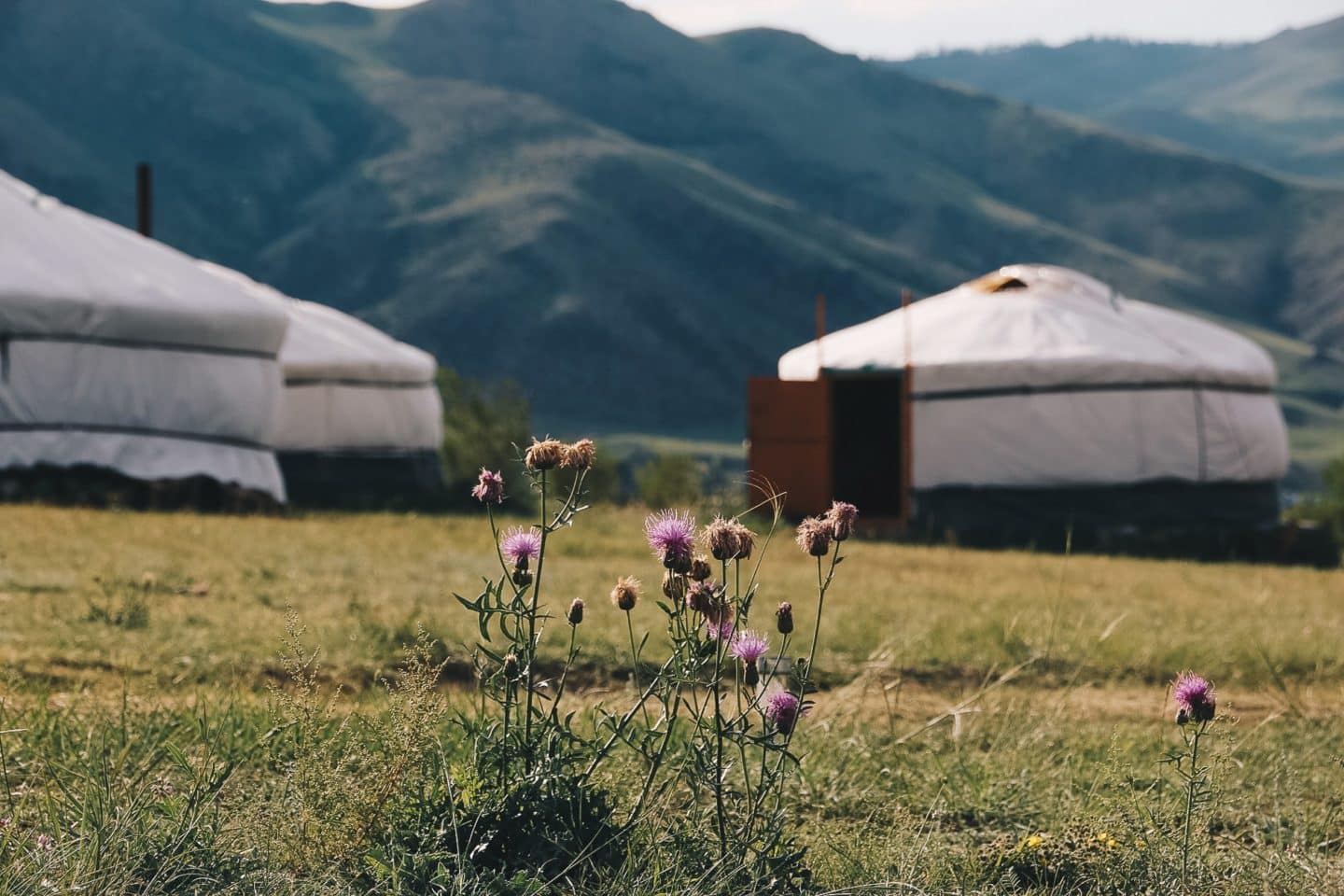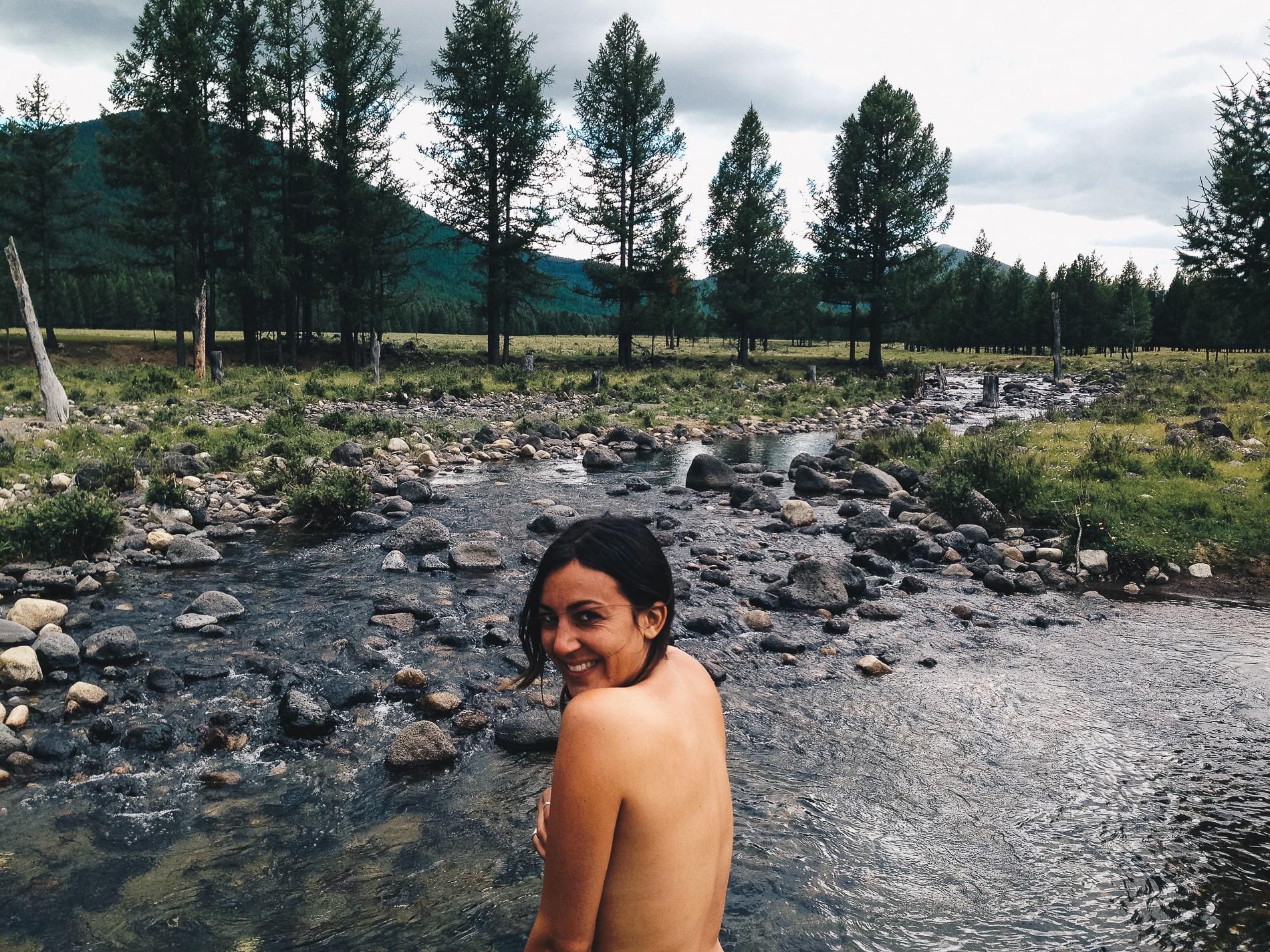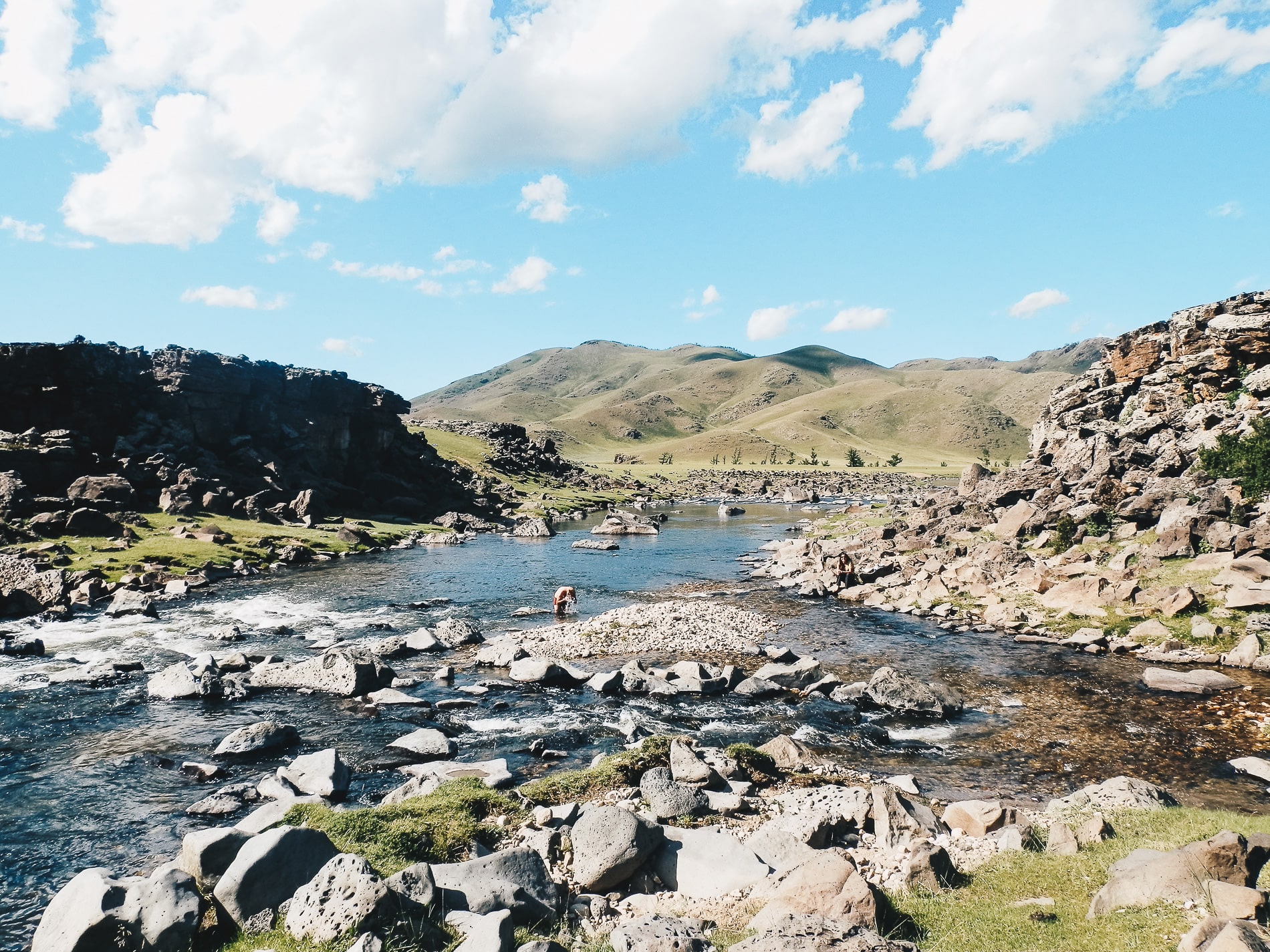
To help you prepare for your stay in Mongolie, noWe’ve put together a handy guide so you won’t be surprised when you arrive.
With its 2 people per km2, Mongolia enchants us with its steppes, its yurts, its endearing locals and its authentic, even rudimentary side. But to avoid any worries, we’d like to give you some valuable advice.
I also invite you to read all our other articles on Mongolia to help you prepare for your trip:
Please note that as an accredited creator of tailor-made trips, I can help you create your own personalized itinerary for your stay in Mongolia. Please send me an email at : contact@mademoiselle-voyage.fr
SEASONS AND RELIGIONS | Mongolie
SOMMAIRE DE L'ARTICLE :
| Which seasons to choose when visiting Mongolia?
- High season extends June to August: hot weather during the day, punctuated by a few thunderstorms in the evening. The end of August is cooler and rainier, so we were glad to have our windbreaker, socks and pants with us! In the Gobi Desert, temperatures can reach 35 degrees during the day. In the evening, the wind is warm and sandstorms or heavy rain can occur. In May, the tourist season gets underway and the weather starts to warm up, but you may see a few snowfalls.
- The Festivals: In July, the Naadam, the traditional Mongolian festival so dear to the hearts of the locals. For several days in the country, fierce battles, archers’ competitions, wrestling… It’s a chance to have fun, get together with friends and family and, of course, put on your best traditional costume. So think ahead and book your accommodation well in advance, as it may well be full! If you’re lucky enough to attend like we are, sample the Khuushuur, these sheep slippers and drink mare’s milk, airag!
- From May to September, it’s more the shoulder season and some yurt camps may be closed. The weather is variable, with perhaps a few cold snaps or snowfalls, but it’s warming up, the planes are filling up and there are more seats on the train, which is the advantage!
- The Basse saison extends from October to April, when many yurt camps and guesthouses close.< According to the locals, it’s freezing cold in December-January and the air in Ulan Bator is very polluted.
- Watch out for the month of February, temperatures are very cold from -15 to -25 degrees, roads can sometimes be blocked by snow. On the positive side, there are many festivals like the khatgal ice festival. the March, in addition to having quite a few flight cancellations, the scenery would be less pretty as the colors turn brown, the winds are strong with sandstorms and it’s a bad time for horses!
| The country’s religions
- Religion: 80% Buddhist, 5% Muslim, 5% Christian, 10% atheist
WILDLIFE ENTHUSIASTS
For wildlife enthusiasts, Mongolia is a magnificent playground. Below is a list of places to go reindeer-watching, horse-riding, fishing…
✖️ Horse-riding in the center and west of the country. The Orkhon Valley and the Great Lakes region is a wonderful souvenir of Mongolia.
✖️ Fishing in the north near lake khovsgol and watch the Rennes.
✖️ Meet the shamans and the last ethnic groups Tsaatanes with their traditional way of life and Rennes breeders. We met a friend who tried this adventure in the north and loved it, but you should know that sleeping in teepees can be tough, as they’re often poorly insulated and rudimentary!
✖️ See majestic eagles in the west of the country
EQUIPMENT
Unfortunately, it’s not the country where you’ll come back super tanned. In Mongolia, the weather changes at breakneck speed, with temperatures fluctuating within the same day and sometimes swinging at night.
Exemple: It can be hot in the morning, then the wind picks up in the afternoon (that’s when you get out your windbreaker) and in the evening, you get out the wool socks, merino wool, pants, silk sheet and sleeping bag before going to bed, because it’s going to be cold… even in front of the fire!
So take items that will protect you in case of rain or snow and keep you warm, especially at the end of the day (we had 2 merino tee shirts to wear as under layers, 1 merino tights, 1 fleece windbreaker, a fleece-lined zipped jacket, wool socks).
For horseback riding, a carrier horse can be made available to take the strain off your back and carry your belongings. So take a medium-sized backpack that’s easy to carry for these few days.
COMFORT AND FOOD
| Is it true that there are no showers in Mongolia?
That’s the first question I’m asked every time, and the answer is yes if you choose a travel mode “roots “. But don’t forget that not taking a shower doesn’t mean you’ll be dirty for 2 weeks! If you wish, you can wash as we did, in streams and rivers when we slept with the nomads, or at the edge of waterfalls.
In our case, we traveled “roots” by making a stop on Oulan Bator in each case, which enabled us to take a shower after a few days’ travel in the Gobi desert. If you choose to do a loop, take along biodegradable wipes for your body and intimate hygiene, washable cotton pads with cleansing milk, micellar lotion, solid and dry shampoo… I managed to stay feminine and presentable over a 17-day stay, so there’s nothing to worry about!
You can also get a luxury break on your trip and sleep in a more luxurious yurt camp with all the comforts that go with it.


| But what do you eat in Mongolia?
That’s the second question I’ve been asked, and the answer is mutton at almost every meal!
As someone who eats almost no meat, I was a little nervous about going to Mongolia! So before setting off, I bought myself some dried fruit, chocolate, potato chips… to fill the gaps in my day. It’s the country where I’ve lost the most kilos, I think 3 or 4kg in 2 weeks. I’ll let you discover some photos of specialties in this article.
The guesthouse who organized our trip was used to travelers, she was very forward-thinking about meals. Breakfasts consisted of sliced bread, butter and jam, accompanied by coffee and tea. As for meals, they were prepared by the nomads, and often included pasta with mutton, rice with mutton, and turnovers stuffed with mutton or yak. On arrival, the locals will often offer you “airag”, fermented mare’s milk to drink, dried cheese to accompany it, butter made from yak or mare’s milk – in short, things that aren’t necessarily appetizing!
DO I HAVE TO SLEEP IN A YURT ALL THE TIME?
You’ll have the choice in Mongolia of sleeping either in tent ( equipment is sometimes loaned by the agency but check well before your departure to see if they provide it locally) or in yourte. I obviously recommend this option, as you’ll have the opportunity to share unique and privileged moments with the locals. This is a fantastic opportunity to experience the real Mongolia in an authentic yurt, not in a tourist camp or campsite!
This man-made accommodation is so practical and not at all restrictive that it can be found all over Central Asia. He says “ger” in Mongolian and are perfectly suited to the nomadic lifestyle, as they can be assembled in 3/4h;
The yurt is made of canvas inside and out. Felt made from sheep’s wool and grass is placed between the 2 layers for insulation. It’s supported by a removable wooden structure and secured with horsehair ropes. Stones are sometimes installed outside and inside in high winds. If you want to experience the “real” Mongolia, prefer an authentic yurt, more basic than a yurt in a tourist camp.
Did you know?
- A yurt weighs about 250kg and costs between 1 and 3 million tons!
- It can be carried by a single camel. Today, Mongolians use the more modern truck to transport it to a new site.
- The yurt door always faces south, as there’s more sunshine and the wind comes from the north.
- The men usually sit on the left, and the women on the right, under the protection of the sun.
- Guests are at the back of the yurt with family photos and valuables. Visitors are always welcome, and there’s no need to knock before entering.
- Nomads generally move their herds 2 to 4 times a year: spring, summer, autumn, winter.
- The yurt plays a key role in family relationships. As the habitat is small, privacy is almost non-existent: everyone sleeps in the same room and shares everything, so the group is closer-knit.
- Modern yurts have all the comforts of an apartment (TV, radio) and Mongolians often have a generator or small solar panels to charge their appliances. In some chic camps , models have evolved, sometimes with windows and bathrooms integrated into the yurt.
HOW TO ORGANIZE YOUR TRIP
A trip to Mongolia is not a trip to Southeast Asia in terms of price and organization!
✖️ Firstly, the plane tickets are more expensive, with a return flight from Paris costing around €900/p.
✖️ Secondly, accommodation is less varied: you sleep either in a yurt or in a tent, but in a yurt the price is obviously a little higher.
✖️ Finally, the transport: you can often take local transport (except for the Gobi Desert), provided you have plenty of time to spare. You can also rent a 4×4 for 2 or 4 people, but the price is not the same.
Don’t hesitate to ask me if there are any planned departures grouped together in order to graft you onto one of the stays I sell to my customers. This may reduce the cost of your trip a little.
If you organize it yourself, you run the risk:
- of waste a lot of time on site as everything fills up very quickly (we had a lot of trouble finding 4x4s for our roadtrip at the last minute as we wanted to be alone, so without any other travellers. We didn’t want to go with 4 or 6 strangers and were looking for less touristy places where not everyone goes. We wanted to sleep in non-touristy yurts and share real moments with the locals. A lot of agencies offer to integrate groups, but this didn’t correspond to our expectations, the type of trip and it was too much of a factory in my opinion.
- from come across false, unlicensed and uninsured guides. There’s a story that made the news in 2018. A couple chose a guide on their own to spend a few days on horseback. The gentleman fell on stones because of his horse and died of his injuries. The woman wanted to attack the guide, but he was uninsured and therefore not covered for this type of risk. So be careful when choosing your guide. They must have insurance and a license.
Don’t forget that if you’re organizing your own trip, it’s important to speak English to book your accommodation and activities remotely or on site, call back to confirm, make appointments, etc. It’s extra stress and time that you shouldn’t neglect.
If I had to do it all over again today, I’d definitely tell you to go through an agency to organize this trip. Admittedly, this comes at an extra cost, as you’re paying for a service, but it allows you to live the trip, enjoy every moment, avoid generating stress for yourself and meet real, adorable nomad families.
Mongolia’s tariffs have risen sharply since COVID and the war with Ukraine. It’s not an inexpensive destination, but that’s even more apparent today. I can’t offer you a trip for less than €3,000/p for a minimum of 15 days, subject to certain conditions that we can discuss together.
Be aware that in Mongolia, it’s difficult to recharge your cell phone or other devices if you’re sleeping in a tent or yurt, so remember to take a second spare battery or take fewer photos and enjoy the moment.
the wifi works in cities such as Ulan Bator, Dalanzagad and Kharhorin. There’s no wifi in the Gobi desert or on the steppes!
So, are you ready to discover Mongolia?
Please note that as an accredited creator of tailor-made trips, I can help you create your own personalized itinerary for your stay in Mongolia. Please send me an email at : contact@mademoiselle-voyage.fr
Before you leave, don’t forget to read all our other articles on Mongolia to help you prepare for your trip:
